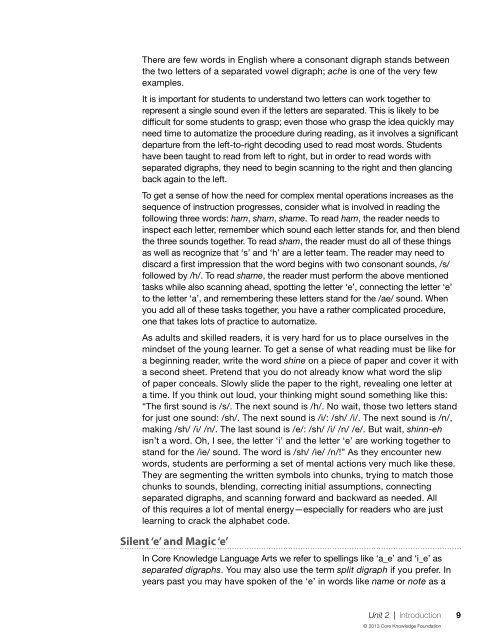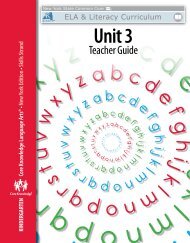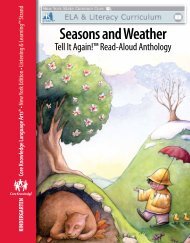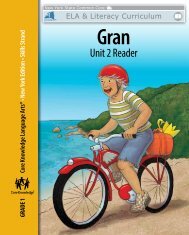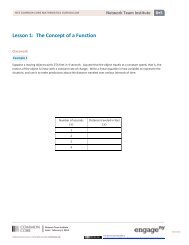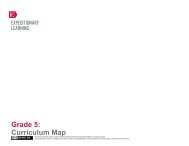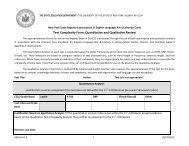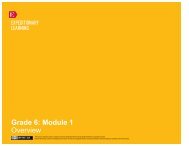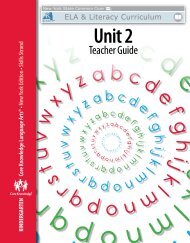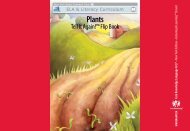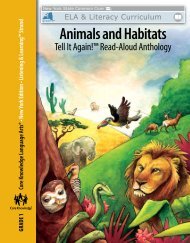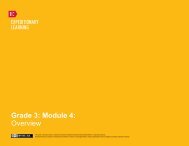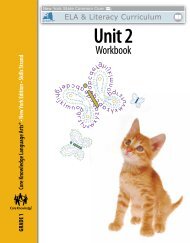Skills Unit 2 Teacher Guide - EngageNY
Skills Unit 2 Teacher Guide - EngageNY
Skills Unit 2 Teacher Guide - EngageNY
Create successful ePaper yourself
Turn your PDF publications into a flip-book with our unique Google optimized e-Paper software.
There are few words in English where a consonant digraph stands between<br />
the two letters of a separated vowel digraph; ache is one of the very few<br />
examples.<br />
It is important for students to understand two letters can work together to<br />
represent a single sound even if the letters are separated. This is likely to be<br />
difficult for some students to grasp; even those who grasp the idea quickly may<br />
need time to automatize the procedure during reading, as it involves a significant<br />
departure from the left-to-right decoding used to read most words. Students<br />
have been taught to read from left to right, but in order to read words with<br />
separated digraphs, they need to begin scanning to the right and then glancing<br />
back again to the left.<br />
To get a sense of how the need for complex mental operations increases as the<br />
sequence of instruction progresses, consider what is involved in reading the<br />
following three words: ham, sham, shame. To read ham, the reader needs to<br />
inspect each letter, remember which sound each letter stands for, and then blend<br />
the three sounds together. To read sham, the reader must do all of these things<br />
as well as recognize that ‘s’ and ‘h’ are a letter team. The reader may need to<br />
discard a first impression that the word begins with two consonant sounds, /s/<br />
followed by /h/. To read shame, the reader must perform the above mentioned<br />
tasks while also scanning ahead, spotting the letter ‘e’, connecting the letter ‘e’<br />
to the letter ‘a’, and remembering these letters stand for the /ae/ sound. When<br />
you add all of these tasks together, you have a rather complicated procedure,<br />
one that takes lots of practice to automatize.<br />
As adults and skilled readers, it is very hard for us to place ourselves in the<br />
mindset of the young learner. To get a sense of what reading must be like for<br />
a beginning reader, write the word shine on a piece of paper and cover it with<br />
a second sheet. Pretend that you do not already know what word the slip<br />
of paper conceals. Slowly slide the paper to the right, revealing one letter at<br />
a time. If you think out loud, your thinking might sound something like this:<br />
“The first sound is /s/. The next sound is /h/. No wait, those two letters stand<br />
for just one sound: /sh/. The next sound is /i/: /sh/ /i/. The next sound is /n/,<br />
making /sh/ /i/ /n/. The last sound is /e/: /sh/ /i/ /n/ /e/. But wait, shinn-eh<br />
isn’t a word. Oh, I see, the letter ‘i’ and the letter ‘e’ are working together to<br />
stand for the /ie/ sound. The word is /sh/ /ie/ /n/!” As they encounter new<br />
words, students are performing a set of mental actions very much like these.<br />
They are segmenting the written symbols into chunks, trying to match those<br />
chunks to sounds, blending, correcting initial assumptions, connecting<br />
separated digraphs, and scanning forward and backward as needed. All<br />
of this requires a lot of mental energy—especially for readers who are just<br />
learning to crack the alphabet code.<br />
Silent ‘e’ and Magic ‘e’<br />
In Core Knowledge Language Arts we refer to spellings like ‘a_e’ and ‘i_e’ as<br />
separated digraphs. You may also use the term split digraph if you prefer. In<br />
years past you may have spoken of the ‘e’ in words like name or note as a<br />
<strong>Unit</strong> 2 | Introduction 9<br />
© 2013 Core Knowledge Foundation


